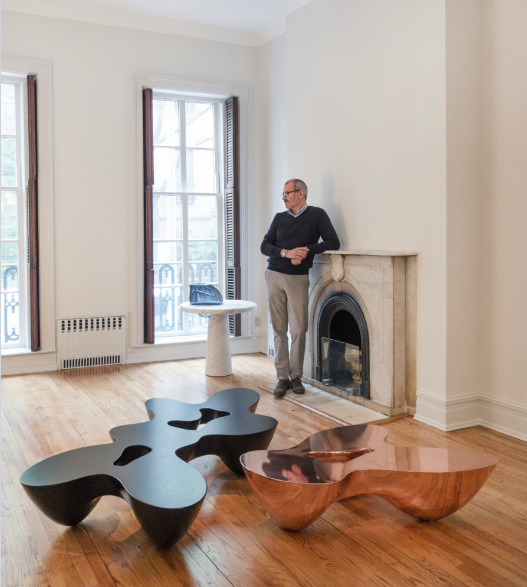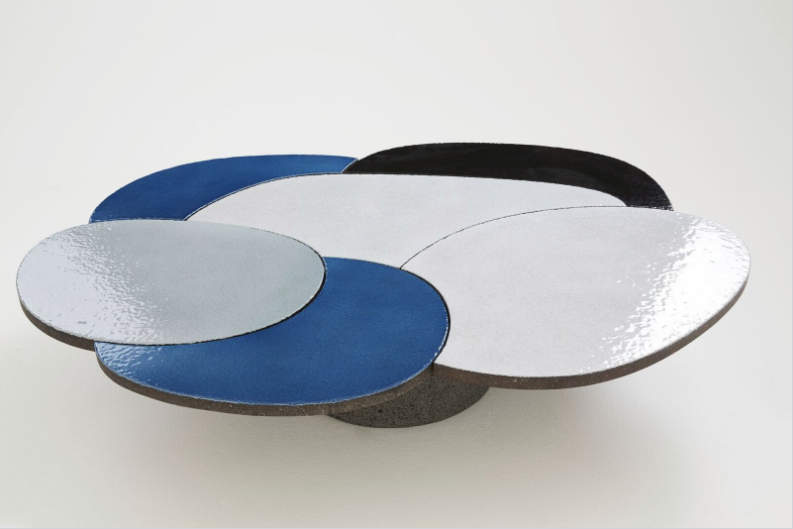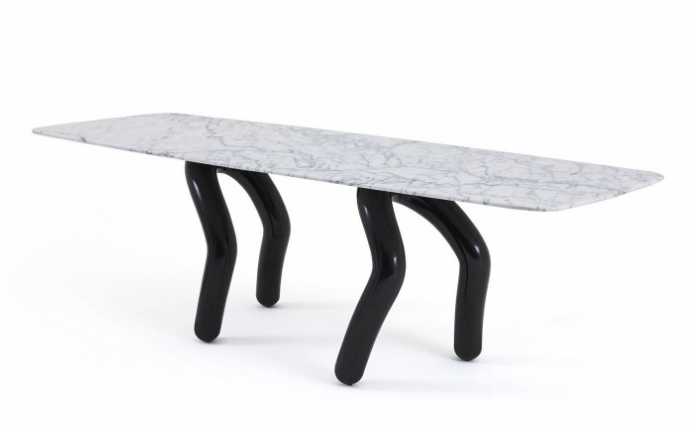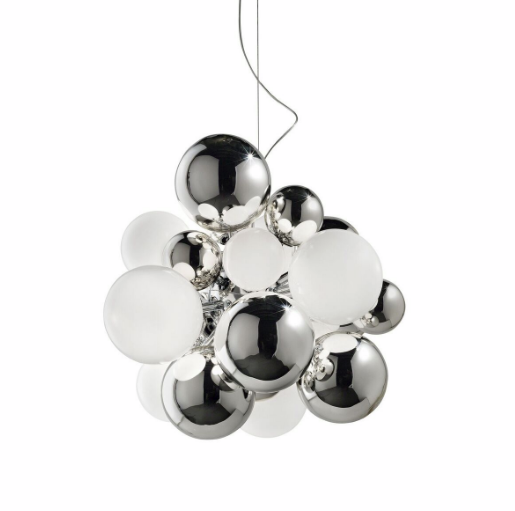Galleries
artnet Asks: Renaud Vuaillat and a New Kind of Design Gallery
Step inside the unique world of this Chelsea dealer.

Step inside the unique world of this Chelsea dealer.

Antje Linck

We’re all familiar with the quintessential gallery setting: a white cube space with vaulting and lofty interiors, often housed in a former warehouse or similar. Twenty First Gallery refreshingly breaks this mold: the 1,000-square-foot exhibition space is nestled in an elegant brownstone right in the heart of Chelsea. Occupying the entirety of the first floor, the Parisian-turned-New York gallery boasts beautiful French doors opening to a terrace and well-landscaped garden.
What truly sets this gallery apart, however, is that its director and founder, Renaud Vuaillat, lives there year-round with his family. With every exhibition, the look of his “salon” changes. Vuaillat was kind enough to invite me into his home so I could learn even more about this unique space. At the bar of his kitchen, amidst outstanding designs of his current show, we chatted about his career in Paris and New York, trends in the art and design world, and the various designers he represents.
Tell us a bit about your early years in Paris. How did you start your business and what was the spirit in the 1990s?
I started to work when I was in my 20s. I opened a booth at the Marché Serpette Flea market, it was fun to be there at this age and during the market’s heyday. In the 90s, the flea market was the center of the antiques trade. It was as though the whole world was coming to buy furniture and objects and the market was as eclectic and diverse as the clientele, which ranged from Parisian and UK dealers to US designers to celebrity clients. I especially remember this episode with Sharon Stone: I was 22, she stopped at my booth and asked if I could recommend a shipping company. I timidly gave her the name of a friend, Francis, who worked at Air Sea Packing at that time. She picked up the phone I had at my booth—a land line—and called the company and asked to speak with Francis. The receptionist said, ‘yes, of course, may I ask who is calling?’ and then promptly hung up the phone when she said, ‘this is Sharon Stone,’ thinking it was a prank call.
The Paris flea markets of the 90s were energetic and fascinating. Business was booming—one USD was 10 francs! Dealers were buying from each other as thousands of pieces circulated through the market, some of them real treasures. I remember seeing this pair of 17th-century Venetian mirrors, taller than me and probably made for a palazzo. They changed hands passing from one booth to the next. I have never seen such pieces since. I was lucky to see and learn so much during that time.

Emmanuel Babled, Etnastone Coffee Table. Courtesy of Twenty First Gallery.
You started with selling 18th-century furniture. What made you turn to contemporary designs?
For the first 10 years, I concentrated primarily on decorative pieces from the 18th and 19th centuries, with a smattering of mid-century Modern pieces. Eventually the 18th- and 19th-century decorative arts market dried up and it was really hard to find quality antiques. During this time, I realized that more and more interesting things were happening in contemporary design. I remember seeing a piece by Hubert le Gall at the 2005 Biennale de la Création des Arts Décoratifs and thinking, ‘this is something from my dreams!’ It was a beautiful bronze guéridon and it met all of my expectations: it was decorative, very elegant, and made of a beautiful material, all with this touch of ‘now’ that was missing in vintage and decorative arts. And it complimented antique pieces very well. The experience marked a new chapter for me in terms of taste and the mixing of periods at the gallery. I was also very happy to finally meet living artists and have the opportunity to discuss their work, which is impossible to do when buying an 18th-century commode!
Why did you choose to move your gallery to New York? In what aspect is the US market different from the European market? What are the challenges in both locations?
After the flea market, I transitioned to a new space and opened a bigger gallery in the more established Saint-Germain neighborhood called Le Carré Rive Gauche. By 1998, a few years before the 2001 recession, the hunt for quality pieces became really challenging and business became less and less interesting, with the most exciting aspect being the buying. I started to believe that a more dynamic market could exist elsewhere, and within a few years, I was traveling back and forth to New York where I saw the opportunity to fully express myself and realize my aesthetic vision. I made Manhattan my permanent home in 2006, just before the 2008 financial crisis. It wasn’t an easy time, but demand remained strong and I was enthralled with all aspects of New York. The US market is great because clients are open to discovering new things. They have a sense of excitement and spontaneity—like kids in a way. It is all about desire, which is very refreshing. This quality is completely missing in France. Parisian life is quiet and pleasant but it doesn’t arouse the same kind of New York enthusiasm. Maybe life is a little more challenging here, but it is also much more exciting.

Installtion view. Courtesy of Twenty First Gallery.
Where do you find the designers you work with? Are you involved in the production process and to what degree do you let clients get involved in this decision-making process?
Each time I meet with a new designer the circumstances are unique, but the relationship always begins with a sincere interpersonal exchange. I find this personal element critical and could not work without this organic rapport. I try to be as involved with the production process as I can—it is one of my favorite aspects of the business. This is easier with some artists than it is with others, but when they allow me to, I bring my experience and perspective without asking that they compromise their art.
The designers you exhibit let me raise the old—but unsolved—question of what is the difference between art and design. How are your designs reflective of the Renaissance idea that artists are craftsmen combining multi-faceted expertise into one discipline?
To define art is difficult, but I am glad people are wrestling with this question as to whether design can be art. The decorative arts was kind of neglected for a while, and I believe it was only because of the functional quality of an object. To me, everything made with love and creativity is a kind of art. It is not enough for an object to be only well crafted or only a good idea—it must be both. A piece of furniture is elevated when the artist has absorbed what was done in the past and is able to imbue this history into a contemporary piece using his own vocabulary. The handmade and ‘savoir faire’ part gives the piece its soul and uniqueness.

Emmanuel Babled, Stepp Table. Courtesy of Twenty First Gallery.
I was fascinated by your explanation why the simplest-looking table is the most expensive object in your current exhibition. Can you please share your thoughts on this with our readers?
The Stepp table, a new piece by Emmanuel Babled, is made of statuary marble and absolute black granite. The table is deceptively simple: its whimsical and anthropomorphic quality lends a touch of humor, as though the table is poised to tip-toe from the room. Babled’s design plays with the appearance of flexibility, a contrast to the hardness and rigidity of the material. From a technical perspective, it was challenging to bring this quality of flexibility to granite. The design was submitted to engineers who devised a hidden metal armature to reinforce the legs and support the weight of the table.
An increasing number of clients for contemporary art are now coming from a banking or tech background. Do you see a similar trend in buying design furniture? What is the future of the trade?
While there is increasingly more money in the sectors you mention, we have collectors from varied backgrounds. For example, they might be younger and more open to collecting and living with contemporary pieces. They also seem less conservative. Design trends have changed along with contemporary architecture: new buildings invite the creation of contemporary interiors. The future of the market is hard to predict and it is changing rapidly, so I have to stay alert. The Internet has undeniably changed the market, with the availability of information making everything more transparent and clients more knowledgeable. This creates opportunities and competition. It’s a global market now, and important sales are also made online. This is a radical change from when I was in Paris, waiting for clients to show up in the 7th arrondissement!
What is your advice to young collectors? What object would you like to buy for yourself this very moment?
I would really advise them to follow their instincts, to have confidence in their taste, not to fear mixing periods, and to be curious and patient. It takes time to learn and acquiring this knowledge is very important.
When is the next gallery opening and exhibition?
We are currently planning several upcoming exhibitions; one to show new pieces by Bernar Venet and another featuring Erwan Boulloud, who has a fantastic following here. I’m also developing a retrospective of Hubert Le Gall’s work. It will be a dream to see Le Gall’s work in the gallery’s intimate interior!
Located at 458 West 22nd Street, Twenty First Gallery is open Monday through Friday by appointment.

Emmanuel Babled, Digit (2008). Courtesy of Twenty First Gallery.